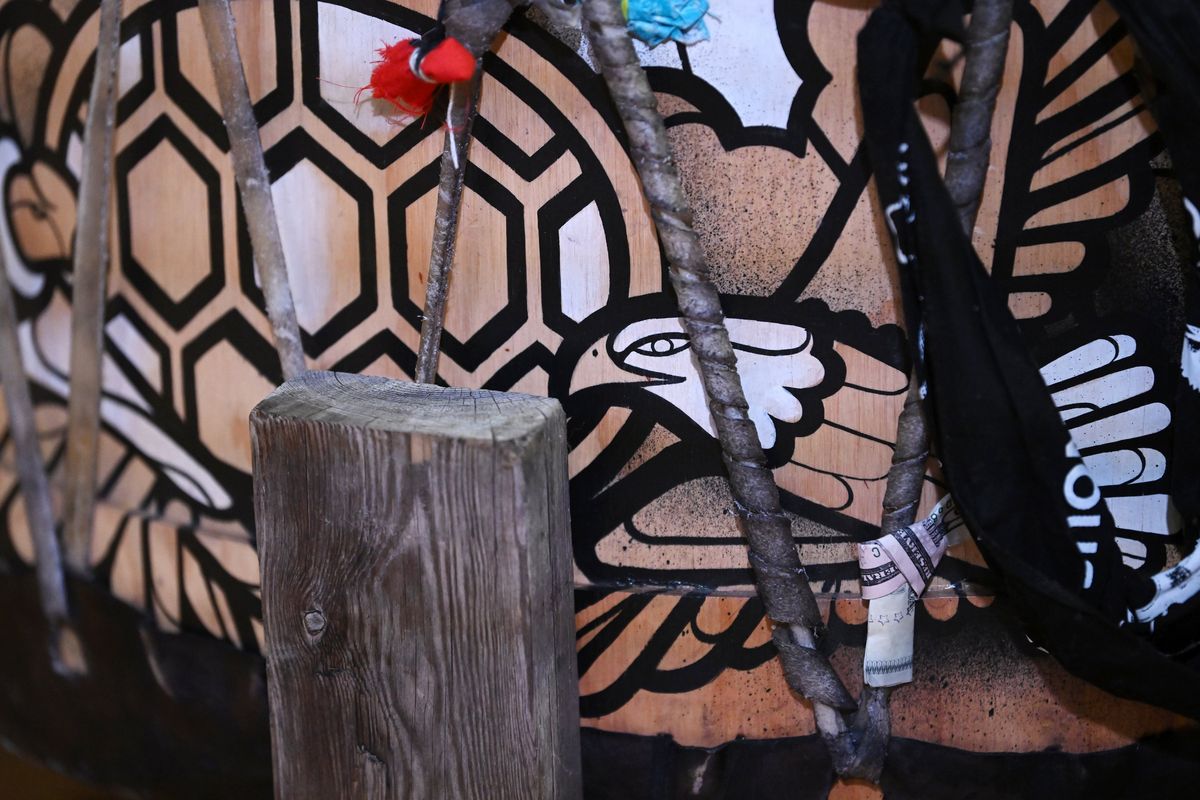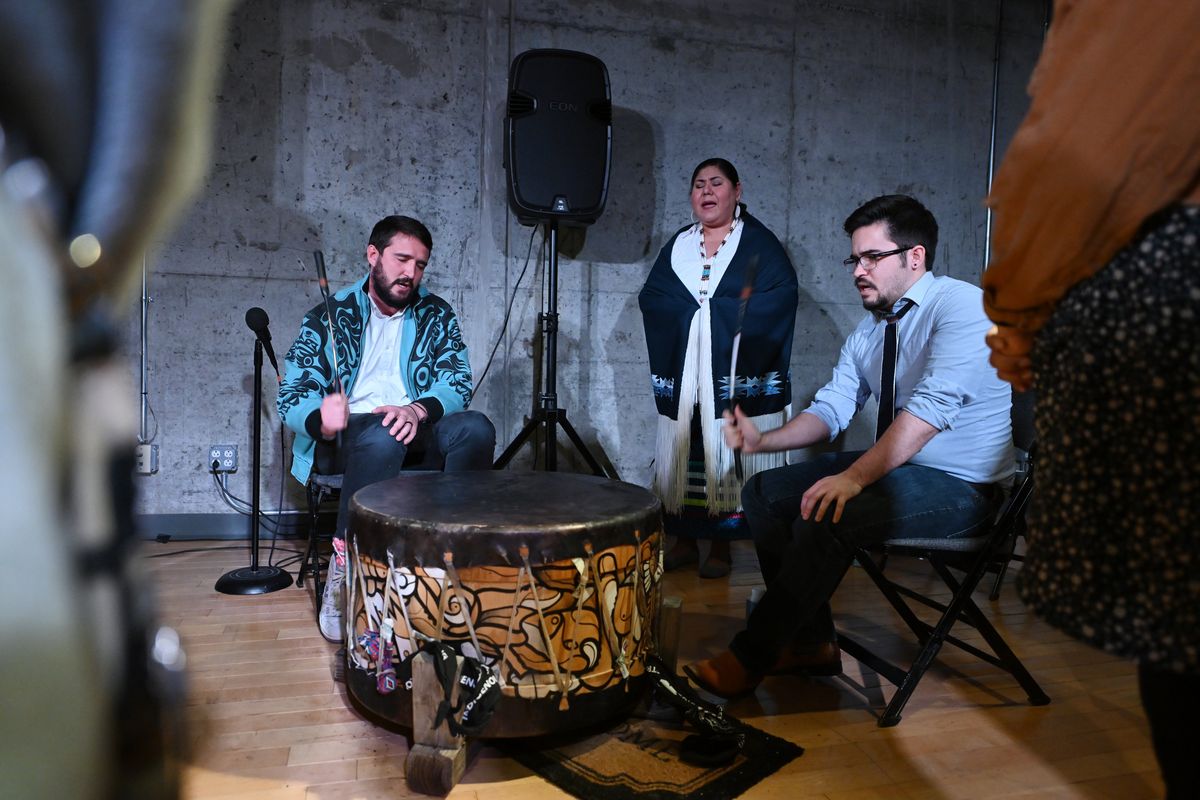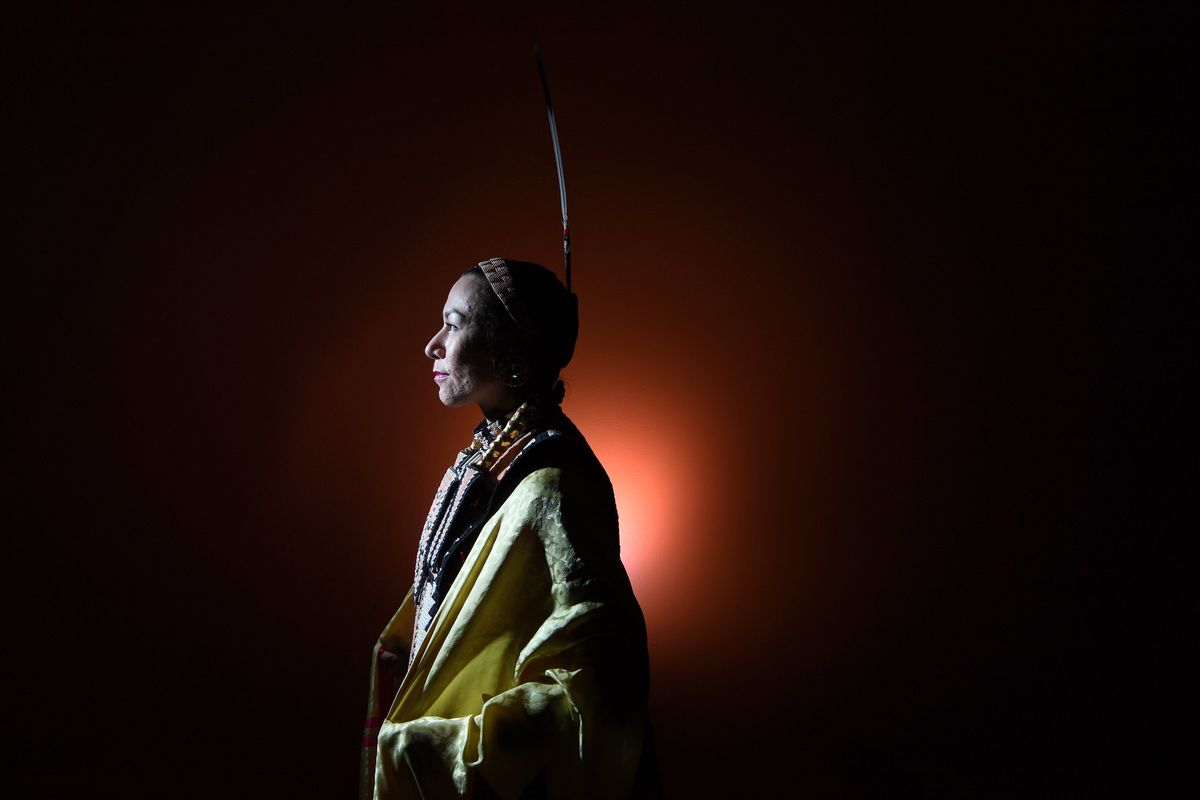Native Americans, far from their tribes, build community around a drum
From left, Nick Courtney, Mary Phillips and Max Yamane of Uptown Singerz perform at the Woolly Mammoth Theatre in Washington, D.C. (Matt McClain/The Washington Post)
When Nick Courtney came to D.C. seven years ago to work on education issues, he missed his Native American tribe in Washington state.
Longing to connect with other Native Americans in the region, the 31-year-old member of the Makah Tribe helped form the Uptown Singerz, a Native American drum group that shares and celebrates their heritage.
“D.C. is a transient city because folks come and go, so that can be hard,” said Courtney, who lives in Baltimore. “I still long for my own culture, but this fills my cup. It’s a bond, and I’m a part of something that’s allowed me to build a community here. It’s like a family for me.”
In the United States, roughly 9.7 million people – or about 3 percent – of the overall population – identified themselves as being American Indian or Alaska Native in the 2020 Census. Fewer than 1% of people in the District, Maryland and Virginia said they are American Indian or Alaska Native.
There are more than 500 federally recognized tribes in the country, and more than 70% of American Indians live away from their tribal reservations or communities.
Being a part of Uptown Singerz gives members who are far from their tribes’ home “a renewed sense of community and family every time we sing, every time we drum,” said Mary Phillips, the group’s lady backup singer (as the role is officially called by Native Americans), who is from the Omaha Tribe in Nebraska and the Laguna Pueblo Tribe in New Mexico. “It’s a way to honor our ancestors and family members who have spent their lives learning these songs, learning the dances.”
The Uptown Singerz have about a dozen members from different tribes across the country. Originally called the Uptown Boyz – because their practice space sat next to the now-closed Uptown movie theater on Connecticut Avenue in Northwest D.C. – they later changed their name to be more inclusive of all their members.
They practice several times a month and perform up to 20 events a year in theaters, rallies, community events and Native American gatherings and powwows in the D.C. region to showcase their talents and educate the public. They, along with the Zotigh Singers – who are from the Kiowa Tribe of Oklahoma and live in Waldorf, Maryland – are one of the few American Indian drum groups in the D.C. region.
“Having the Uptown Singerz is so important because they help keep our culture alive here in D.C.,” said Angela Gladue, 38, who is a powwow and hoop dancer. A Cree and a member of the Frog Lake First Nation in Alberta, Canada, Gladue moved to Northeast Washington six years ago and got to know other American Indians in the area, along with the drum groups.
“When I hear their drum it makes me want to cry,” she said. “It brings back memories of home. It strikes me in the heart.”
The Uptown Singerz typically play around one large drum made from wood and dried animal hide. Sometimes they play smaller hand drums. Considered sacred and often used at events and some ceremonies, the drum for many American Indians represents the heartbeat of Mother Earth.
They follow the Native American tradition of having only men sit around the drum. Women stand behind them and join in the singing because “women carry the sacred water of life,” empowering them to “absorb or change the energy of the people around them or the energy of the drum,” Phillips said.
Historically, Phillips said, Native American powwow drum songs were considered “war dance songs” for warriors: “They were a homecoming or send-off for them to say, ‘We honor you. We have these songs for you. We will dance for you.’”
Now these songs have become a way of healing, according to some Uptown Singerz. Some songs celebrate elders or a harvest. Others honor people who have died or recognize military veterans, according to Phillips.
As the men drum, they sing with the women in tribal languages or sounds at high or low pitches. Tribes from north of Kansas and up to Canada usually do a Northern Plains style drum like the Uptown Singerz – with a faster beat and vocal sounds at a higher pitch.
“We’re making these sounds the way the Creator taught us,” said Shawn Ironmaker, 53, who’s Native American, lives in Southwest D.C. and is part of the Uptown Singerz. “The combined sound with the beat of the drum removes all negative energy around you and replaces it with positive energy.”
The sound of a drum, to many American Indians, is spiritual. For some, it gives them a connection to their ancestors or homelands. For others, the songs tell their tribe’s story or improve their moods and bring good health.
Max Yamane, a 28-year-old who lives in Silver Spring and is a member of the Uptown Singerz, said drumming and singing is a good way for younger Native Americans to learn – and practice – tribal languages, some of which have lost their fluent elder speakers.
The Uptown Singerz drum a wide range of songs from different tribes. Some are from the Blackfoot, Nakoda, Cree and Lakota tribes. One Ojibwe traveling song – meant to give well-wishes to those who come to an event and hopes they make it home safely – includes a verse that translates, “It’s because of you that is why we’re walking in this way.”
In late May, the Uptown Singerz, Zotigh Singers and other drummers held a round dance – a social dance that included Native Americans from different tribes and guests and was done to honor families and ancestors – at the Kennedy Center. Roughly 200 people attended.
For Gladue, hearing the drum and seeing American Indians from different tribes gather and dance was a special moment.
“A lot of people see me and assume I speak Spanish,” she said. “Or people will ask, ‘Indians are still here?’ To be around other Natives and not have to explain myself makes me feel good. We get each other, based on who we are.”
For Ironmaker, sharing his singing and drumming is a way to show that Native Americans continue to “thrive and survive.”
“You can get lost in society and in an urban area, but we’re trying to keep our heart and not lose our culture and identity,” Ironmaker said. “It’s important as Native American people to remind ourselves who we are and where we come from.”
—-
Video Embed Code
Video: The Uptown Singerz performed in January 2023 at the Woolly Mammoth Theatre in Washington, D.C., along with powwow and hoop dancer Angela Gladue.(REF:hedgpethd/The Washington Post)
Embed code: {iframe src=”https://www.washingtonpost.com/video/c/embed/6d43aef1-c772-4454-b143-8d4a85f5aa8c?ptvads=block&playthrough=false” frameborder=”0” width=”480” height=”290”}{/iframe}
Video: The Uptown Singerz, a Native American drum group in the D.C. region, performs with other guest drummers at the Kennedy Center’s REACH area on May 16. They’re one of only a few Native American drum groups in the area and their performances are a draw for Indigenous people to recognize their culture and heritage.(REF:hedgpethd/The Washington Post)
Embed code: {iframe src=”https://www.washingtonpost.com/video/c/embed/eac177bc-b13a-4a60-a479-b16c5a503009?ptvads=block&playthrough=false” frameborder=”0” width=”480” height=”290”}{/iframe}



